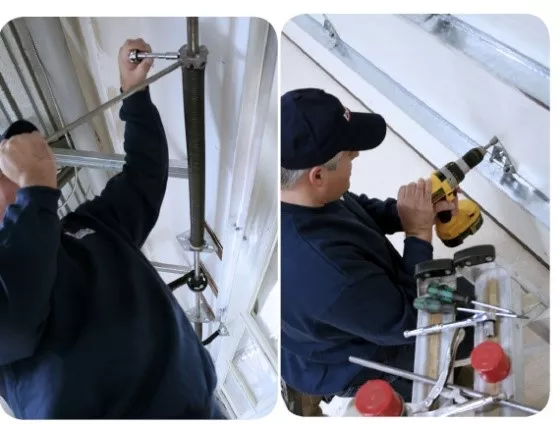
Avoid spring break? Never! But that is precisely what most homeowners say they’d like to do when it is a spring that breaks on their garage door. Witty word play aside, the sound made by a snapping lifting spring is not joke. In fact, the volume and intensity of it will reverberate throughout the house and send everyone running towards the garage to find out if a small bomb exploded.
Oddly enough, the design of the springs is meant to protect the vehicles and space from damage, so many homeowners don’t even know it broke until they try to open the door. This is when they glance up and see what has occurred. Most are shocked that such an important component would just snap, and they fear they missed warning signs or did something wrong. There are just a few reasons this can happen, so let’s take a look and figure it all out!
The Importance of the Springs
First and foremost, let’s consider the importance of the spring system. It is a crucial component of the garage door opener, and you should know just what it does in order to recognize the need for upkeep and care.
There are two varieties of spring systems:
-
EXTENSION SPRING
Positioned on each side of the door, the springs are positioned over the horizontal tracks. They take their names from the way they operate. They sit in a coiled position until the garage door is lifted or lowered, and then “extend” to do the work. They should be connected to safety cables that ensure no damage occurs if the springs snap. After all, they are under a lot of pressure, and if they break at the wrong moment, they can strike the car, a person nearby or items in the garage, causing serious harm.
-
TORSION SPRING
You find these springs within steel tubes positioned above the door and attached via an anchor plate (to the centre of the door). There are some that have plates at the far end of the tracks due to lack of head room, and you might hear them called low headroom or double horizontal track systems.
And how do these springs work? Basically, they are both designed to work as counterweights to the weight of the garage door, itself. These can be much heavier than you realize because the typical door feels like it might weigh only eight to ten pounds. Well, that is the springs at work because a standard 9’ x 7’ door (with windows) weighs 135 lb. (61 kilo.) – not something you could lift with a single hand!
And yet, a properly chosen, installed and balanced spring system does make the door feel just that light. Now, you might wonder why an electric garage door opener would need the door to feel lighter. After all, most are designed to lift upwards of 200 lb. (90 kilos). Here’s the thing about door openers – they are actually designed to be a substitute for a manual lift. In other words, to lift what we might be asked to lift and not hundreds of pounds!
And while lifting the door is impressive, keep in mind that the systems also have to be able to push the same amount of weight downward when closing the door. This is why it can be so harmful to be in the path of a closing garage door.
Is it the weight of the doors that cause the springs to snap? Actually, no…
Why Lift Springs Break
We should correct that answer and say, it is not the only reason. Springs might also break because of:
- Wear and Tear – All mechanical items and parts have expected life spans, and both the extension and torsion springs are meant to last around 5‑7 years. They are described as 10,000‑cycle spring systems meaning that they should be able to open and close ten thousand times (a cycle is a single open and single close). But think of that, if you use the door two to four times every day, it adds up! It is around 1500 cycles a year. If you use your garage door more than 5 times a day, be aware that 20 to 25,000 cycle springs are available from some manufacturers.
- Problem with Manufacturing – Defects in manufacturing are a reality in all industries. If it is an extension spring, it is likely that the defect occurs in the final ring at the end, but with torsion springs it is often that low quality galvanizing leads to rust and weakness, and then a break.
- Problem with calibration – No one is perfect, as they say, and you might find that the person who originally installed the door and spring system chose the wrong system. Though the door functions, there is too much stress on the springs, the electric opener or the door itself and this causes a break. Consider that springs are meant to operate properly with a 5% variation. Thus, the spring designed to lift a 100‑lb. (45‑kilo) door cannot be installed on a 150‑lb. (68‑kilo) door without consequences.
- Problems with the garage environment – A cold and damp garage without any sort of heat or insulation is not going to offer much protection to the springs or the opener. Even if the garage is beneath a house, if it is cold and wet inside, it can cause deterioration to parts – especially galvanized springs. Since any material that has undergone galvanization is only up to 40% galvanized, rust can still cause problems. And if the interior is intensely cold (such as under -15F (-26F)), the coiled metal wire can dry out and break.
- Problems with upkeep – Maintenance is essential, but many homeowners forget about the garage doors until they have problems. All doors and lifting systems need upkeep, which is why Garaga recommends twice‑yearly lubrication of metal parts that come into contact with other ones. With the arrival of cold weather, this becomes even more important if you wish to avoid breaks or deterioration.
Are You Ready to Overcome the Risks of a Lousy Spring “Break”?
If you are worried that you might experience that not‑so‑desirable type of spring break, we suggest that you make it a habit to lubricate your garage door springs twice each year. Use a petroleum‑based oil, like motor oil for your car (ex.: 10W30) and NOT WD40 as it is a degreaser and will cause serious problems. Wipe the oil on the coils with a rag and be sure to wipe away any excess. That’s it! Garaga dealers carry the lubricants you’ll need that are made for garage doors to make it even easier!
Maybe you would prefer someone else to apply lubricant and inspect the door once or twice per year? We can provide a “Garage Door Tune‑up” program similar to the kind of winter tune up a mechanic might make on your vehicle!
If this appeals to you, just contact us. We’ll be glad to advise you and offer the right choices based on your needs and your budget. We are also glad to post a quotation by email. You should also consider a visit to our showroom, and if you are interested in a new garage door, you can use the Design Centre to help you choose a style that fits your home or view our image gallery for inspiration.







Add new comment